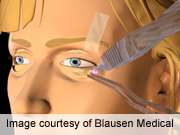Fat preservation better for lower eyelid blepharoplasty

(HealthDay)—Fat preservation and grafting techniques have gained popularity in lower eyelid blepharoplasty, according to a surgical pearls piece published online June 26 in JAMA Facial Plastic Surgery.
David J. Archibald, M.D., from the Center for Plastic Surgery at Castle Rock in Colorado, and Edward H. Farrior, M.D., from the Farrior Facial Plastic & Cosmetic Surgery Center in Tampa, Fla., advise surgeons on patient selection and surgical technique when using fat repositioning in lower eyelid blepharoplasty.
The authors define fat repositioning as the repositioning of the lower eyelid pseudoherniated orbital fat inferiorly over the orbital rim, repositioning the suborbicularis oculi fat (SOOF) superiorly over the orbital rim, or a combination of both techniques. They note that fat excision is now recognized as failing to address the tear trough deformity and leads to increased skeletonization of the orbital rim and a hollowed-out appearance of the lower eyelid-cheek complex. By comparison, preservation and repositioning of the SOOF and/or orbital fat restore this smooth convex transition to the malar eminence. However, fat-repositioning techniques have some disadvantages, including a steep learning curve, prolonged edema, and a visible scar if performed via a transcutaneous approach.
"We believe that this repositioning is a more physiologic approach to the sequela of the aging lower eyelid-cheek complex," the authors write.
More information: Full Text (subscription or payment may be required)
Copyright © 2014 HealthDay. All rights reserved.

















